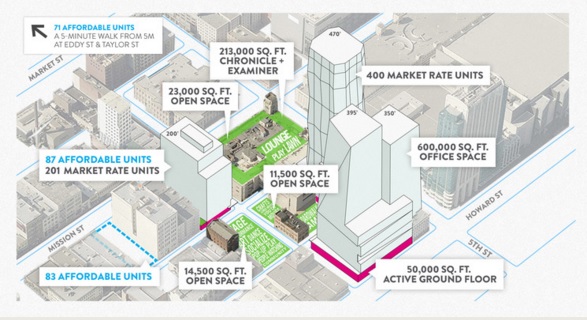And the role of Sup. Jane Kim in cutting a deal on one of them is raising all sorts of questions

By Tim Redmond
(UPDATED — this story is updated to include comments from Sup. Kim)
NOVEMBER 16, 2015 – Major development projects in the heart of Soma and along the waterfront will come before the Board of Supervisors Tuesday/17, and there’s a storm brewing over the role Sup. Jane Kim played in cutting a deal with one of the building groups.
It’s possible that one or both projects could be decided by a narrow margin, meaning the outcome would be different if they were delayed even a few weeks until Aaron Peskin replaces Sup. Julie Christensen.
The simpler of the two in procedural terms is 75 Howard. It’s currently a parking garage, which can hardly be called the best use of the property. The developer, however, wants to put a 220-foot building on the site, all market-rate housing (of course) – and the appellants have a lot of issues, but the biggest one is that the city has consistently moved away from upzoning the waterfront. And this building is at Howard and Steuart, right off the Embarcadero, and would cast a significant shadow on Rincon Park.
The Planning Commission certified an Environmental Impact Report that relied on a traffic study using baseline data from five years ago – and one that, the appellants argue, is so far out of date that it can’t adequately address the impact of the project. Dave Osgood, who filed the appeal on behalf of the Rincon Point Neighbors Association, also notes that the EIR didn’t consider seriously whether the project could go forward at the existing building’s height because, the report says, that wouldn’t be financially feasible.
According to the appeal:
Help us save local journalism!
Every tax-deductible donation helps us grow to cover the issues that mean the most to our community. Become a 48 Hills Hero and support the only daily progressive news source in the Bay Area.
The FEIR, however, has provided no evidence to support this assertion – the FEIR simply asserts that the alternative would not have “sufficient economic viability to warrant construction of such a building.” While the City is correct that economic feasibility is not required to be discussed in an EIR, where the EIR rejects an alternative on the basis of financial feasibility the EIR should include sufficient analysis to support that conclusion.
That’s an interesting issue. The project sponsor argues in its brief that the city wasn’t required to analyze a smaller alternative, but there’s no discussion anywhere of what “sufficient economic viability” means. We hear this all the time from developers: If I can’t have what I want, then I won’t be able to build. That typically means: If I can’t have what I want, I won’t make as huge a profit as I’ll make if I have to build smaller (or add more affordable housing, or whatever).
There’s no law that requires private developers on private land who get no city subsidies to make public their finances, but it’s worth talking about.
The other, much more complex, project is the massive complex planned for Fifth and Mission, sponsored in part by Hearst Corp., which owns the Chronicle. The plan involves more than 800,000 square feet of office space, which would mean about 3,200 new workers. (That’s assuming 250 square feet per employee, which is probably high; tech companies often use 200 square feet or even less, which means more workers crammed into the office complex.)
It’s likely many of those workers will be people who move here from somewhere else.
The project will create about 600 housing units, not even enough for half the workforce.
So from the start, the plan would make the city’s housing crisis worse.
It’s also, opponents argue, inconsistent with the city’s existing plan to create a Filipino Cultural Heritage District and “will unnecessarily impact surrounding neighborhoods and result in the displacement of the Filipino community.”
And it will “Obliterate the Youth and Family Special Use District,” according to the appeal by the South of Market Community Action Network, the South of Market Action Committee and Save our SoMa.
Now here’s where it gets strange. The Board of Supervisors has to approve the development agreement for the project, and make some zoning changes to allow it. The supes also have to sit as quasi-judges on the appeal of the EIR and the Conditional Use permits, and they aren’t supposed to endorse or oppose the project before they consider those appeals.
At the Land Use Committee Nov. 9, all three members – Malia Cohen, Scott Wiener, and Jane Kim – carefully voted to send the measure to the full board without recommendation. But Kim announced that she had cut a deal with the project sponsor to increase the affordable housing component from 33 percent to 40 percent.
The low-income part of that – 71 units – will be built off site, in the Tenderloin. The on-site units will be targeted to people who make 100-150 percent of the area median income.
So in a sense, opponents say, Kim has already said she supports the project. At the hearing, she said:
“I want to acknowledge Forest City and Hearst Corporation for working closely with my office to reach this deal … And in voting no on a project where a developer is willing to come to this standard will ensure that no other developer will ever commit to 40% affordable housing.”
It would be highly unusual for a supervisor to make a deal with a developer – one that includes significantly increased affordable housing – and then turn around and vote to kill the project by upholding an appeal over the EIR and conditional use authorizations.
So the opponents have asked that Kim recuse herself from voting on the appeal. Here’s what the letter from attorney Rachel Mansfield-Howlett, representing SOMCAN and the others, says:
Appellants have a fundamental right to a fair hearing involving unbiased decision makers. The Board of Supervisors is the ultimate decision making body in this matter. Accordingly, each Board of Supervisor must protect the parties’ due process rights, including barring private communications with any party behind closed doors, pursuant to San Francisco Sunshine Ordinance (S.F. Adm. Code Ch. 67).
By, privately meeting with the developer to negotiate a non-public deal and by expressing her support for the revised Project, Supervisor Kim cannot fairly consider the merits of the appeal and her actions have negatively prejudiced the appeal process.
Citizens now pose the following question. Were any other Supervisors involved in the privately negotiated deal with the developers? Citizens also request a 60-daycontinuance to resolve this question.
Kim told me that she can’t comment on the legality of her actions, since she’s asked the city attorney for advice. But she said she was in touch with the community activists all along: “We met many times over the last two years, and at least three times leading up to the Land Use [hearing] and [talked] over the phone,” she told me.
But Dyan Ruiz, a spokesperson for the project foes, told me that none of the activists knew anything about the deal Kim had cut “until we read about it in the press.”
The whole thing raises these kinds of tricky issues that come into play when elected officials are able to negotiate with developers – and community advocates aren’t in the same room.
In this case, Kim told me that the groups Ruiz represents weren’t interested in cutting a deal for higher affordability. They wanted a very different, smaller project from the start. “So no, they weren’t in the room, because they didn’t want to negotiate on this issue,” she said.
Kim was clearly out to demand more affordable housing — 0h, and to set the standard, as she did with the Giants, that 40 percent is the new required level. (SOMCAN was very involved in the Giants deal, Kim said.)
Forty percent is a lot better than the 12 percent the city requires, and a lot better than we’ve gotten in many other projects.
But that assumes that it’s better to build the project in the first place. If 5M creates more jobs than housing, by a long shot, and if many of them are high-end jobs that then create other spillover jobs for people who make less money and have nowhere to live, then the net impact is bad for the city, right?
We drive out the Filipino community and give the Hearst Corp. huge profits (for land, by the way, that the company has owned for years, land that used to be owned by the family that owned the Chronicle, that’s been paid for generations ago and that has no – zero – acquisition cost.)
And this is the best we can do?
The appeal will be technical, all of these things are, and when the supes consider the EIR, they will have to vote on whether the report is accurate, not on whether the project makes sense. The conditional use appeal is a bit different – the supes can say that the EIR is legally sound, but the special permission the Planning Commission gave to this developer isn’t warranted. Even if the developer is a partnership that includes the city’s biggest daily newspaper.
Jane Kim is one of the progressives on the board, and if the appeal were to have any chance of success, the odds are she would have to be among the Yes votes. If she can’t vote at all, the foes still need six to uphold the appeal.
So recusing her might not help the appeal. But delaying it for 60 days absolutely will, because we will see a different board in 60 days.
The vote will be a big deal. The meeting starts at 2pm, and this will be heard around 3pm. Expect a packed room.
Two big events this week: Jobs with Justice celebrates its fifth anniversary Thursday/19, and El Tecolote celebrates its 45th Friday/20.



